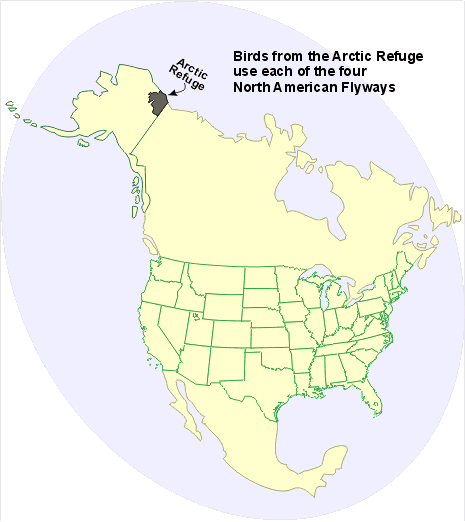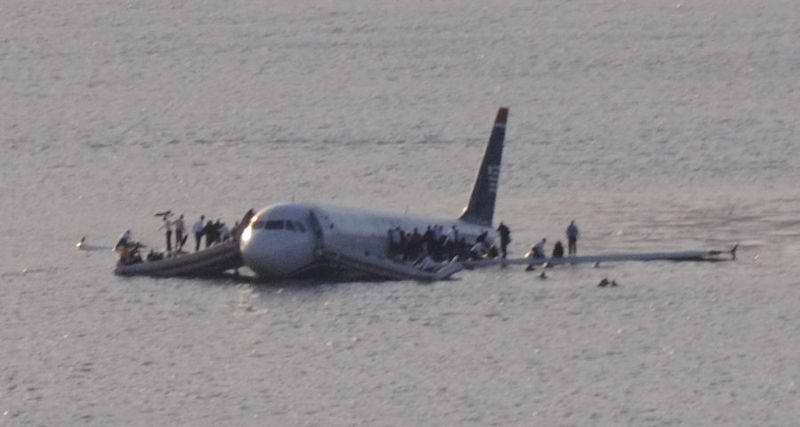Wildlife Hazards
Bird activity increases because of migration activities during March through April, and August through November.
Introduction
Introduction
- Birds and other wildlife pose severe hazards to pilots during day and night, especially in the terminal area
- Migratory activity is generally predictable along recurring flyways, but their appearance on your route of flight will always be unexpected
- Proper background and preflight planning can help mitigate the risks of a bird strike
- Although steps can be taken, sometimes bird strikes will happen, which warrant a report
Migratory Bird Activity
Migratory Bird Activity
- Bird activity increases because of migrations during March through April and August through November
- The altitudes of migrating birds vary with winds aloft, weather fronts, terrain elevations, cloud conditions, and other environmental variables
- While over 90% of the reported bird strikes occur at or below 3,000 feet AGL strikes at higher altitudes are common during migration
- Pilots have frequently observed ducks and geese up to 7,000' AGL, requiring caution by pilots to minimize en route flying at lower altitudes during migration
- Migratory bird activity is considered the most significant potential hazard to aircraft because of their size, abundance, or habit of flying in dense flocks are gulls, waterfowl, vultures, hawks, owls, egrets, blackbirds, and starlings
Migratory Flyways
Migratory Flyways
-
Major Migratory Flyways:
- The Atlantic Flyway: parallels the coast
- The Mississippi Flyway: stretches from Canada through the Great Lakes and follows the Mississippi River
- The Central Flyway: represents a broad area east of the Rockies through central America
- The Pacific Flyway: follows the west coast
-
Other Migratory Flyways:
- There are also numerous smaller flyways which cross these major north-south migratory routes
Reducing Bird Strike Risks
Reducing Bird Strike Risks
- When encountering birds en route, climb to avoid a collision because birds in flocks generally distribute themselves downward, with lead birds being at the highest altitude
- Avoid overflight of known areas of bird concentration, but if unavoidable, do not fly at low altitudes
- Charted wildlife refuges and other natural areas contain an unusually high local concentration of birds, which may create a hazard to aircraft
- The FAA's wildlife strike database provides historical data using various parameters
Reporting
Reporting
-
Bird Strikes:
- The most severe strikes are those involving ingestion into an engine or windshield strikes
- Engine ingestion may result in the sudden loss of power or engine failure
- Windshield strikes have resulted in confusion, disorientation, loss of communications, and aircraft control problems
- Timely reporting allows Air Traffic Control, as well as other pilots in the area, to remain proactive
- If a bird or other wildlife strike occurs, then report it using FAA Form 5200-7, Bird/Other Wildlife Strike Report available in the AIM Appendix 1, FSS, FAA offices, or online at https://www.faa.gov/airports/airport_safety/wildlife/
- Reports inform the development of standards to cope with potential hazards and for documentation of necessary habitat control at airports
- Additionally, completed reports are available to pilots for learning from other's experience
-
Wildlife Activity:
- Many airports advise pilots of other wildlife hazards caused by large animals on the runway through the Chart Supplement U.S. and the NOTAM system
- If birds or other animals are observed on or near the runway, request airport management to disperse the wildlife before taking off
- Also, contact the nearest FAA ARTCC, FSS, or tower (including non-Federal towers) regarding large flocks of birds and report:
- Geographic location
- Bird type
- Approximate numbers
- Altitude
- The direction of the birds' flight path
- Also, contact the nearest FAA ARTCC, FSS, or tower (including non-Federal towers) regarding large flocks of birds and report:
Avian Hazard Advisory System
Avian Hazard Advisory System
- The United States Air Force has developed a Bird Avoidance Model (BAM) using Geographic Information System (GIS) technology as a key tool for analysis and correlation of bird habitat, migration, and breeding characteristics, combined with key environmental and man-made geospatial data
- This model is applied through the Avian Hazard Advisory System, generally targeted toward military operations
- Though not targeted at civilians, the models available can be a useful tool in civilian flight planning, especially in areas expected to be at greater risk
- Risk is provided in the form of a condition code on which to base a go or no-go decision
-
Avian Hazard Condition Codes:
-
Severe:
- Bird activity on or immediately above the active runway or other specific locations representing a high potential for strikes
- Supervisors and aircrews must thoroughly evaluate mission needs before conducting operations in areas under condition SEVERE
-
Moderate:
- Bird activity in locations representing the increased potential for strikes
- BWC moderate requires increased vigilance by all agencies and supervisors and caution by aircrews
-
Low:
- Bird activity on and around the airfield represents a low potential for strikes
-
Flights Over Charted U.S. Wildlife Refuges, Parks, and Forest Service Areas
Flights Over Charted U.S. Wildlife Refuges, Parks, and Forest Service Areas
- It is prohibited to land an aircraft on lands or waters administered by the National Park Service, U.S. Fish, and Wildlife Service, or U.S. Forest Service without authorization from the respective agency except for:
- When forced to land due to an emergency beyond the control of the operator
- At officially designated landing sites
- An approved official business of the Federal Government
- Pilots are requested to maintain a minimum altitude of 2,000' above the surface of the following:
- National Parks
- Monuments
- Seashores
- Lakeshores
- Recreation Areas and Scenic Riverways administered by the National Park Service
- National Wildlife Refuges
- Big Game Refuges
- Game Ranges and Wildlife Ranges administered by the U.S. Fish and Wildlife Service
- Wilderness and Primitive areas administered by the U.S. Forest Service
- FAA Advisory Circular AC 91-36, Visual Flight Rules (VFR) Flight Near Noise Sensitive Areas, defines the surface of a national park area (including parks, forests, primitive areas, wilderness areas, recreational areas, national seashores, national monuments, national lakeshores, and national wildlife refuge and range areas) as the highest terrain within 2,000' laterally of the route of flight, or the uppermost rim of a canyon or valley
- Federal statutes prohibit certain types of flight activity and/or provide altitude restrictions over designated U.S. Wildlife Refuges, Parks, and Forest Service Areas
- Designated areas such as Boundary Waters Canoe Wilderness Areas, Minnesota; Haleakala National Park, Hawaii; Yosemite National Park, California; and Grand Canyon National Park, Arizona, are charted on Sectional Charts
- Federal regulations also prohibit airdrops by parachute or other means of persons, cargo, or objects from aircraft on lands administered by the three agencies without authorization from the respective agency except when facing:
- Emergencies involving the safety of human life
- The threat of serious property loss
Bird Hazards Case Studies
Bird Hazards Case Studies
- NTSB Identification: DCA09MA026:
- The ingestion of large birds into each engine resulted in an almost total loss of thrust in both engines and the subsequent ditching on the Hudson River. Contributing to the fuselage damage and resulting unavailability of the aft slide/rafts were (1) the Federal Aviation Administration's approval of ditching certification without determining whether pilots could attain the ditching parameters without engine thrust, (2) the lack of industry flight crew training and guidance on ditching techniques, and (3) the captain's resulting difficulty maintaining his intended airspeed on final approach due to the task saturation resulting from the emergency situation
Conclusion
Conclusion
- Preflight planning information can be found at http://www.usahas.com/
- During the past century, wildlife-aircraft strikes have resulted in the loss of hundreds of lives worldwide and billions of dollars in aircraft damage
- The FAA maintains a comprehensive program to address wildlife hazards
- Through policy and guidance, research, and outreach, we strive to stay ahead of the issue
- Any emergency requires prompt action by the pilot; however, be particularly familiar with the engine out procedures when in the vicinity of known bird hazards
- Collisions of landing and departing aircraft and animals on the runway are increasing and are not limited to rural airports
- These accidents have also occurred at several major airports. Pilots should exercise extreme caution when warned of the presence of wildlife in and in the vicinity of airports
- Following a bird strike incident, first and foremost, fly the aircraft and land safely
- The ability to fly the aircraft may be challenging enough depending on where the aircraft hit, what systems are effected, and if the pilot themselves have physical injuries
- The FAA accepts reports through their wildlife strike website and publishes data through their hazard mitigation website.
- Next, ensure the aircraft is appropriately inspected, repaired, and reports (per the FAA form) are filed
- Interestingly, birds fly at night at about the same frequency as during the day
- Furthermore, birds tend to be VFR creatures and avoid clouds
- Remember that in addition to birds, other animals pose strike hazards
- Still looking for something? Continue searching:
References
References
- Advisory Circular (91-36) Visual Flight Rules (VFR) Flight Near Noise Sensitive Areas
- Advisory Circular (150/5200-32) Reporting Wildlife Aircraft Strikes
- Aeronautical Information Manual (7-5-1) Migratory Bird Activity
- Aeronautical Information Manual (7-5-2) Reducing Bird Strike Risks
- Aeronautical Information Manual (7-4-3) Reporting Bird Strikes
- Aeronautical Information Manual (7-5-4) Reporting Bird and Other Wildlife Activities
- Aeronautical Information Manual (7-5-5) Pilot Advisories on Bird and Other Wildlife Hazards
- Aeronautical Information Manual (7-4-6) Flights Over Charted U.S. Wildlife Refuges, Parks, and Forest Service Areas
- AIN - Researchers See the Light To Reducing Bird Strikes
- Aircraft Owners and Pilots Association - Proficient Pilot: Flying is for the birds
- International Airport Review - Mitigating the growing threat of wildlife hazards at airports
- Federal Aviation Administration - Pilot/Controller Glossary
- Federal Aviation Administration - Wildlife Hazard Mitigation
- Federal Aviation Administration (InFO 23005) Bird Strike Safety Information for Helicopter Operations, is now published
- Flight Information Handbook (B-24) USAF Bird Hazard Condition Codes
- U.S. Fish and Wildlife Service - Migratory Birds
- United States Air Force - Avian Hazard Advisory System

